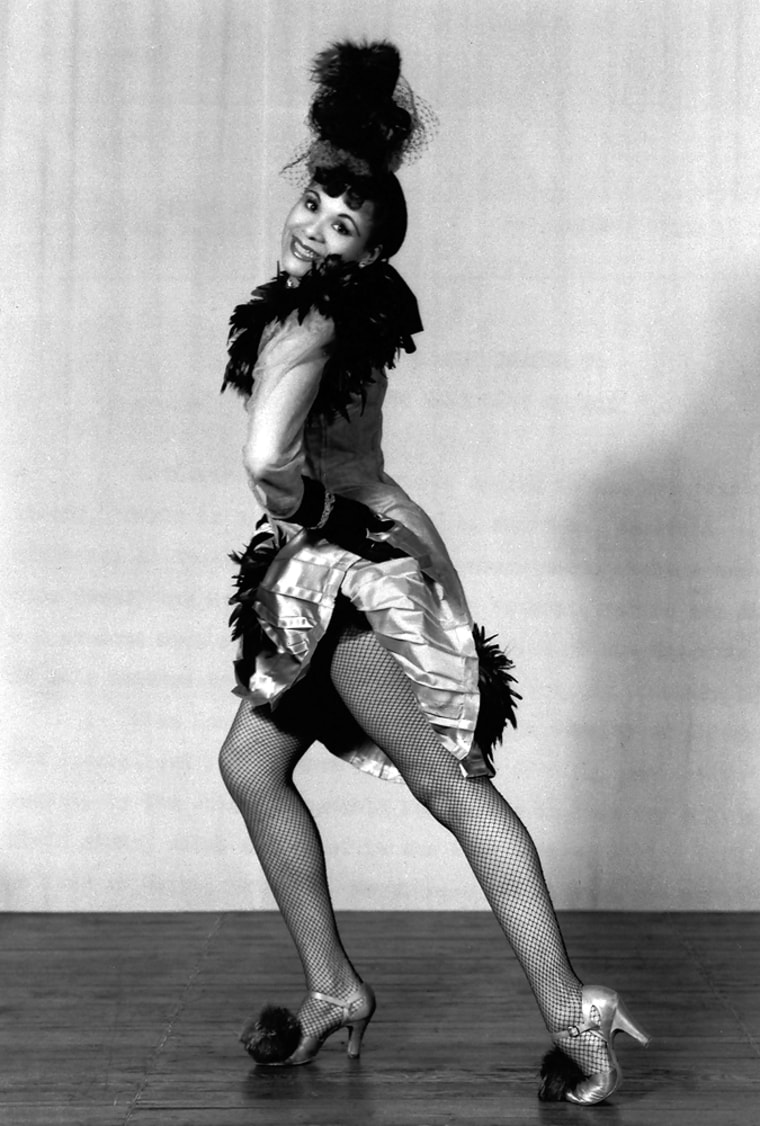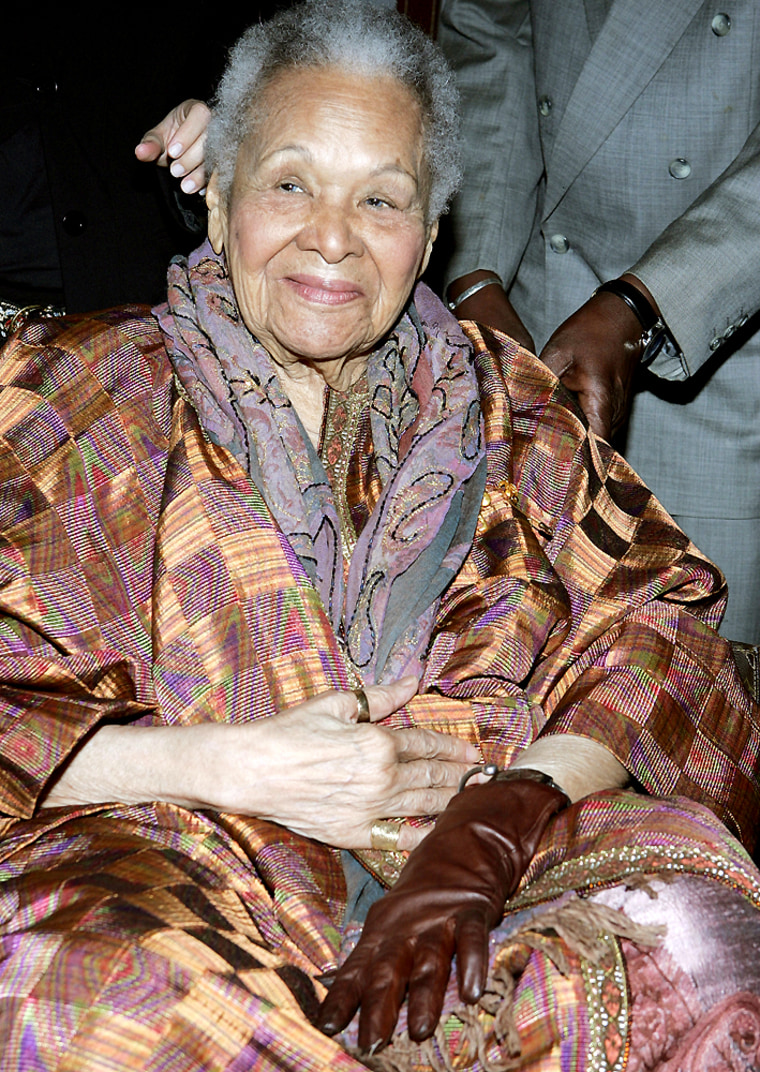It was a bitterly cold winter day three years ago when I last saw the pioneering choreographer Katherine Dunham teach. She was rolled into the Howard University dance studio in her wheelchair, bundled up like a prized antique. First a thick fur blanket was peeled off, then a woolen wrap, and then Dunham herself was revealed, somewhat hunched, wearing lots of gold jewelry. Peering through her oversize glasses at the more than 100 students sitting on the floor in front of her, she got right to work.
"Think of everything you learn from me today as part of a way of life," she announced in a low, raspy voice. "Now — breathe."
This was not as simple as it sounds. For Dunham, a tireless activist who died Sunday at the age of 96, invested every aspect of her life — indeed, you could say, every breath — with meticulous attention and an unflinching eye.
And on this day in January 2003, that eye didn't see much it liked. Dunham hollered at the dancers to tilt their heads back, to hold their stomach muscles in, to undulate with the breath inside them. Then, unsatisfied with the beat that the drummers alongside her were producing, she leaned out of her wheelchair, grabbed one of their drumsticks and began keeping time on the table in front of her.
A few beats later, that tiny old lady had all the drummers grooving together and the whole room full of young adults breathing in unison.
Dunham's dance technique and her way of life went hand in hand. She was inquisitive, blazingly energetic and exacting as a dancer and a choreographer, but she didn't leave those qualities behind after the curtain fell. Her whole long life was about questions and activism and energy. The path that led her to Broadway, Hollywood and concert stages around the world eventually took her to Haiti, where she lived for a number of years, working feverishly and, to her great distress, ultimately unsuccessfully to bring about change for that nation's desperately poor people.
Academics, showbiz and sex
In her unparalleled career in dance, where she educated the world about the power of African dance as found throughout the diaspora, Dunham mixed academic research and showbiz flair. An anthropologist as well as a choreographer, she studied dance in the Caribbean islands, blending movements she found there with Western dance. Her style was not scholarly; she reveled in eroticism. She sought not to re-create specific rites but to transport the audience the way a spiritual experience might. And she wasn't afraid to use sex to do this. A sensuous performer, she frequently wore costumes that revealed well-muscled thighs and ample curves.

There were other dancers interested in Afro-Caribbean arts — Pearl Primus, also an anthropologist, for one — but Dunham had the most far-reaching success, perhaps because of her utter fearlessness. She founded her company in the 1930s, when a predominantly black dance troupe was unheard of. Her voluptuousness as a dancer made her especially marketable — because, let's face it, audiences at that time were not especially sensitive to the art she was creating. She caught the eye of ballet master George Balanchine, who created the role of the sexpot Georgia Brown for her in the 1940 Broadway hit "Cabin in the Sky." Dunham and her company performed in other Broadway revues, and she also made her mark choreographing for film, in 1943's "Stormy Weather" and several others, in Hollywood and abroad.
But her twin artistic achievements were her body of choreography — works such as "L'Ag'Ya," a story of love and death, and "Shango," drawn from Trinidadian cult rituals — and the development of her own method of dancing.
"Dunham technique" became part of the bedrock of American modern dance, like the techniques of Martha Graham, Jose Limon and Merce Cunningham. Through her own flamboyance and interpretive beauty as a performer, as well as her rigor as a teacher, she raised African-based dance to a new level.
‘She set the bar’
Growing up in an America that offered few opportunities for blacks, Dunham served as an inspiration to black artists who saw her achievements as especially formidable given the racism of the times.
"She set the bar for attaining excellence in art and she instilled in us a great sense of pride in our blackness," said singer Harry Belafonte, speaking by phone yesterday from California. Belafonte and his wife, Julie, were close friends of Dunham's for half a century, he said. Julie was member of Dunham's company; Harry credits Dunham with encouraging him to investigate the music of her beloved Haiti.
Without Dunham's effort to "reveal to me the beauty of that music," Belafonte said, he would never have recorded songs like the gentle, lilting ode "Yellow Bird."
Not afraid to breathe fire
However attuned she was to musical beauty and island mysticism, Dunham could breathe fire in the studio. She was a legendary taskmaster, and even in her nineties, during that class I witnessed at Howard as part of the International Association of Blacks in Dance Conference, she was capable of whipping her students into a lather.
"Now think of your anal opening!" she cried at one point. "Does everyone know what your anal opening is? Think of a pole from the top of your head through that hole. That's your strength!"
"Don't be nervous, don't be tired and above all, don't be bored," she lectured them. "Those are the three destroyers of freedom of movement."
She called on the dancers to be "strong and easy at the same time," swaying in her wheelchair, her arms floating, responding to the drumbeat with a remarkable fluidity.
Her eyes never strayed from the dancers, who by the end of the class were trying to keep up the relentless tempo on their tiptoes, with bent knees, stamping and shimmying their shoulders, adding turns if they could. Dunham technique seeks to balance tricky polyrhythmic equations, with the head nodding out one beat and torso and legs keeping time with another.
The trick, say those who have mastered it, is to move with such musical and muscular intricacy that you achieve complete freedom. Dunham was scheduled to teach for an hour; she kept at it for two.
Strength amid weakness
Not long after that class, I visited Dunham in her Manhattan apartment. She was in bed, where she spent much of her time when she wasn't making appearances. She suffered from crippling arthritis and had had both kneecaps replaced. Reclining against a mound of pillows, wearing a peacock-blue top, and fixing me with her dark, wide-set eyes, she spoke not of weakness but of strength.
"There is a need in the body to express itself," she said. "Every culture has its own form of physical expression. An unfortunate thing about today — about Western dance — is it's too competitive in feeling. I don't dance because I can do this movement better than you. I do it because it's what I feel, and want to do."
"When I first saw how ever-present and powerful dance was," she said, "it came as a wonderful revelation."
Pressed regarding about her views on dance, though, it became clear she was speaking less about dance and more about an area of equal concern: human rights.
"It's a real job to recognize dance at all," she continued. "Until our Western need to compete begins to slow down and becomes a need to feel and love and express motion and care for our inner selves as well as our outer selves . . . if we can find a way to live in union with other people —" She looked out the window at her view of the skyline. "We have to love ourselves, love what we are doing, and find a way to express these things in unity with other people."
Confronted politics
Dunham banged up against politics as she sought to spread her teaching in the island she so loved.
"Long before she could teach the healthy minds, she needed the healthy bodies," Belafonte said. She found herself feeding the students, seeing to their health care and welfare, and eventually spreading this concern into a wholesale human rights activism that included a hunger strike of 47 days in 1992 to protest the U.S. policy of deporting Haitian refugees. Sadly, most of her good works there came to naught without government support to sustain them.
"She didn't perform miracles, she performed acts of human kindness," Belafonte said. "Which should be viewed as a miracle in itself."
